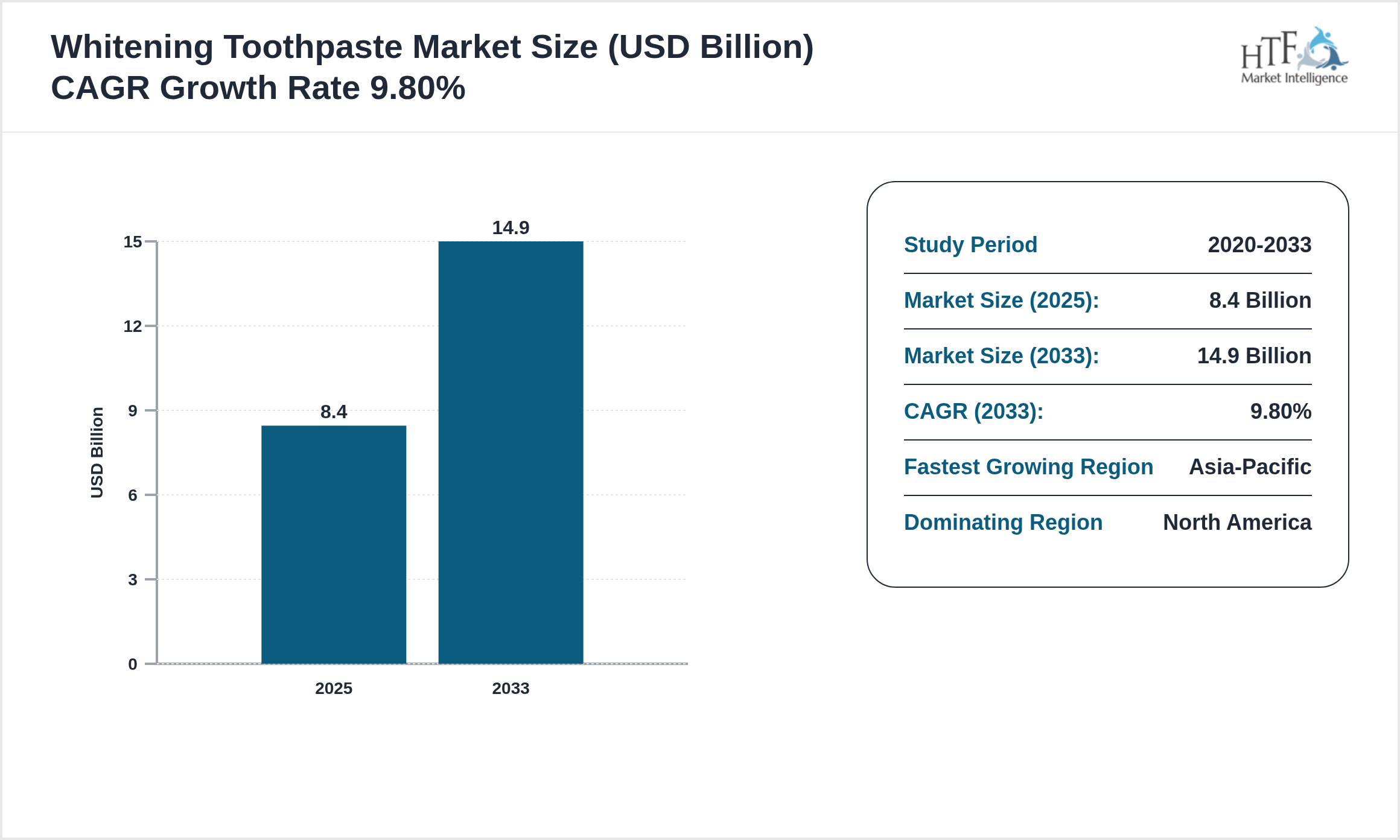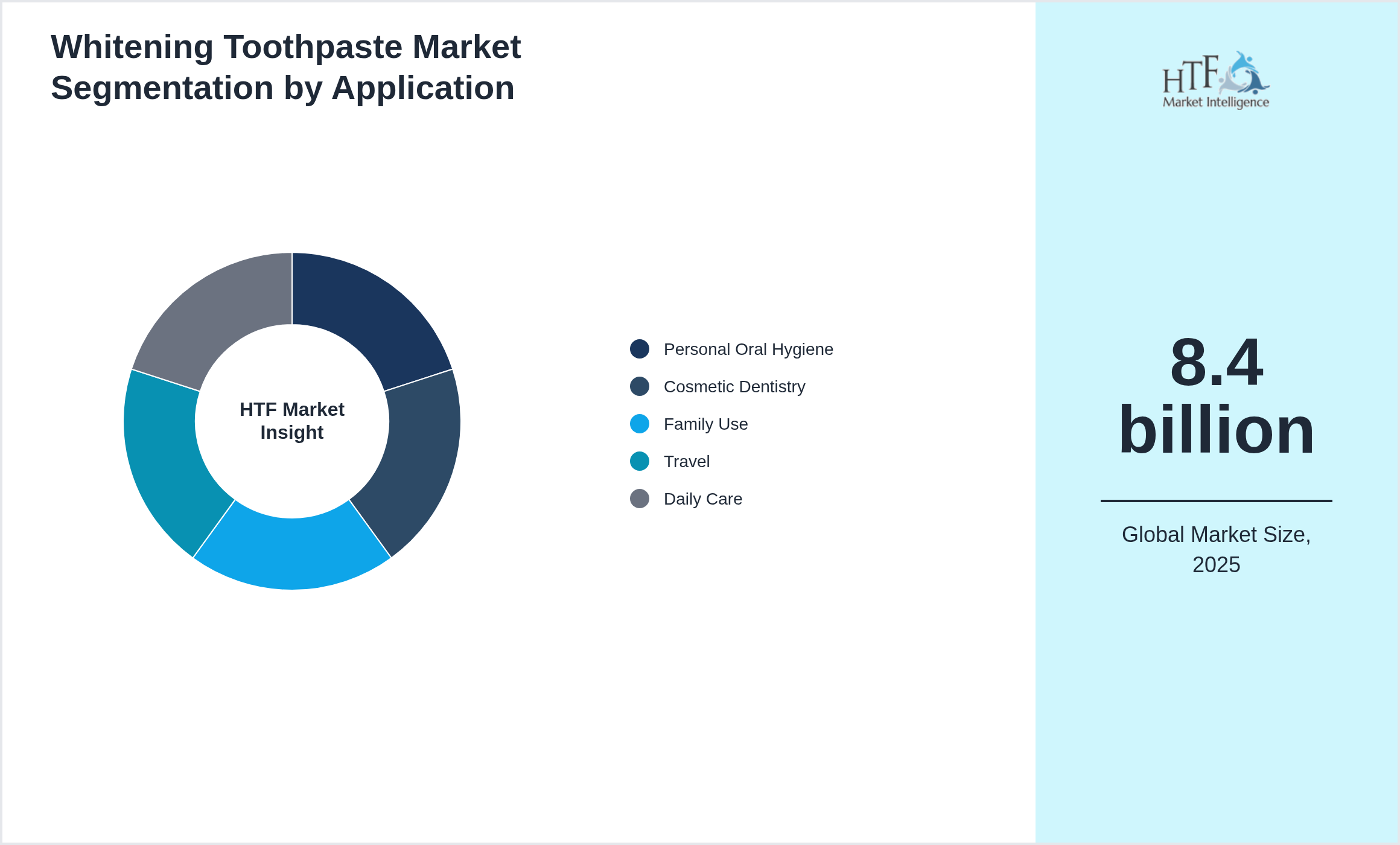Whitening Toothpaste Market Research Report
Whitening Toothpaste Market - Global Size & Outlook 2020-2033
Global Whitening Toothpaste Market is segmented by Application (Personal Oral Hygiene, Cosmetic Dentistry, Family Use, Travel, Daily Care), Type (Fluoride-Based, Charcoal-Based, Baking Soda-Based, Enzyme-Based, Herbal), and Geography (North America, LATAM, West Europe, Central & Eastern Europe, Northern Europe, Southern Europe, East Asia, Southeast Asia, South Asia, Central Asia, Oceania, MEA)
Pricing
The Whitening Toothpaste is growing at 9.80% and is expected to reach 14.9 billion by 2033. Below are some of the dynamics shaping the Whitening Toothpaste.
The whitening toothpaste market includes products formulated to remove stains and enhance tooth brightness. Growth is driven by rising awareness of oral aesthetics, cosmetic dentistry trends, and increasing consumer disposable income. Whitening toothpaste types include fluoride, charcoal, baking soda, enzyme-based, and herbal options, catering to different preferences and oral health requirements.

Key Highlights
· The Whitening Toothpaste is growing at a CAGR of 9.80% during the forecasted period of 2020 to 2033
· Year on Year growth for the market is {YOY_GROWTH}
· Based on type, the market is bifurcated into Fluoride-Based, Charcoal-Based, Baking Soda-Based, Enzyme-Based, Herbalsegment dominated the market share during the forecasted period
· Based on application, the market is segmented into Personal Oral Hygiene, Cosmetic Dentistry, Family Use, Travel, Daily Care
· {Report_Region} Import Export in terms of K Tons, K Units, and Metric Tons will be provided if Applicable based on industry best practice
The Whitening Toothpaste industry study provides important insights in several important ways. To help stakeholders quickly understand key information, it starts with an executive summary that briefly summarizes the results, conclusions, and practical suggestions. The purpose and questions being addressed are guaranteed to be understood when the study objectives are clearly stated. To build credibility, the methodology section explains the research techniques used, such as surveys and focus groups, and why they were chosen. The Whitening Toothpaste industry landscape, including market size, growth trends, and major drivers, is presented in a market overview.
The segmentation research also examines different market categories to determine client wants. The competitive analysis highlights the advantages and disadvantages of the main rivals. Key facts and insights are presented at the end of the study, followed by conclusions and suggestions that offer doable tactics to direct future company choices.
Schedule a personalized consultation with our industry analysts
Regional Coverage
The North America leads the market share, largely due to rising consumption, a growing population, and strong economic momentum that boosts demand. In contrast, the Asia-Pacific is emerging as the fastest-growing area, driven by rapid infrastructure development, the expansion of industrial sectors, and heightened consumer demand, making it a critical factor for future market growth. The regions covered in our report are
This report also splits the market by region:
- North America
- LATAM
- West Europe
- Central & Eastern Europe
- Northern Europe
- Southern Europe
- East Asia
- Southeast Asia
- South Asia
- Central Asia
- Oceania
- MEA
Whitening Toothpaste Dynamics
GROWTH DRIVERS: The Whitening Toothpaste is propelled by several key drivers, including the demand from diverse industrial sectors such as automotive, construction, and pharmaceuticals. Technological advancements and continuous innovation in chemical processes enhance efficiency and open new market opportunities. Economic growth, particularly in emerging markets, along with rapid urbanization and population growth, increases the need for chemicals in infrastructure and consumer goods. Additionally, stricter environmental regulations and the push for sustainable products drive the development of green chemicals. Global trade, raw material availability, and investments in research and development further shape the industry's growth, while supportive government policies and evolving consumer trends also play crucial roles.
- • Rising Demand For Cosmetic Oral Care
- • Growth In Dental Awareness
- • Desire For Brighter Smiles
- • Rising Disposable Income
- • Increasing Urbanization
- • Expansion In Natural Ingredients
- • Growth Of Whitening Kits
- • Integration With Dental Clinics
- • Increased Adoption Of Subscription Models
- • Rising Demand In Urban Centers
- • Tooth Sensitivity Issues
- • Regulatory Compliance
- • Price Sensitivity
- • Misleading Claims
- • Limited Awareness In Emerging Markets
- • Focus On Natural Ingredients
- • Integration With Electric Toothbrushes
- • Rise Of Subscription Toothpaste Services
- • Development Of Whitening Kits
- • Eco-Friendly Packaging
Regulatory Framework
Several regulatory bodies oversee the chemical industry globally to ensure safety, environmental protection, and compliance with standards. Notable among these are the Environmental Protection Agency (EPA) in the United States, the European Chemicals Agency (ECHA) in the European Union, and the Occupational Safety and Health Administration (OSHA) in the United States. Other significant entities include the Health and Safety Executive (HSE) in the United Kingdom, the National Institute of Chemical Safety (NICS) in South Korea, and the Ministry of Environmental Protection (MEP) in China.
Additionally, the National Industrial Chemicals Notification and Assessment Scheme (NICNAS) in Australia, the Japan Chemical Industry Association (JCIA), the Canadian Environmental Protection Act (CEPA), and the Central Pollution Control Board (CPCB) in India play crucial roles. These organizations establish regulations, conduct inspections, and enforce compliance to ensure the safe production, handling, and disposal of chemicals.
Market Segmentation Analysis
Segmentation by Type
- • Fluoride-Based
- • Charcoal-Based
- • Baking Soda-Based
- • Enzyme-Based
- • Herbal

Segmentation by Application
- • Personal Oral Hygiene
- • Cosmetic Dentistry
- • Family Use
- • Travel
- • Daily Care

Competitive landscape
The key players in the Whitening Toothpaste are intensifying their focus on research and development (R&D) activities to innovate and stay competitive. Major companies, such as Colgate-Palmolive (US), Unilever (UK), GlaxoSmithKline (UK), Procter & Gamble (US), Dabur (India), Himalaya (India), Lion Corporation (Japan), Johnson & Johnson (US), Sensodyne (UK), Marvis (Italy), Tom's of Maine (US), Hello Products (US), Crest (US), Close-Up (UK), Pepsodent (India), are heavily investing in R&D to develop new products and improve existing ones. This strategic emphasis on innovation is driving significant advancements in chemical manufacturing processes and the introduction of sustainable and eco-friendly products.
Moreover, these established industry leaders are actively pursuing acquisitions of smaller companies to expand their regional presence and enhance their market share. These acquisitions not only help in diversifying their product portfolios but also provide access to new technologies and markets. This consolidation trend is a critical factor in the growth of the Whitening Toothpaste, as it enables larger companies to streamline operations, reduce costs, and increase their competitive edge.
For the complete companies list, please ask for sample pages
In addition to R&D and acquisitions, there is a notable shift towards green investments among key players in the Whitening Toothpaste. Companies are increasingly committing resources to sustainable practices and the development of environmentally friendly products. This green investment is in response to growing consumer demand for sustainable solutions and stringent environmental regulations. By prioritizing sustainability, these companies are not only contributing to environmental protection but also positioning themselves as leaders in the green chemistry movement, thereby fueling market growth.
The companies highlighted in this profile were selected based on insights from primary experts and an evaluation of their market penetration, product offerings, and geographical reach.
- • Colgate-Palmolive (US)
- • Unilever (UK)
- • GlaxoSmithKline (UK)
- • Procter & Gamble (US)
- • Dabur (India)
- • Himalaya (India)
- • Lion Corporation (Japan)
- • Johnson & Johnson (US)
- • Sensodyne (UK)
- • Marvis (Italy)
- • Tom's of Maine (US)
- • Hello Products (US)
- • Crest (US)
- • Close-Up (UK)
- • Pepsodent (India)

Merger & Acquisition
Report Infographics
Report Features | Details |
Base Year | 2025 |
Based Year Market Size 2025 | 8.4 billion |
Historical Period | 2020 to 2025 |
CAGR 2025 to 2033 | 9.80% |
Forecast Period | 2025 to 2033 |
Forecasted Period Market Size 2033 | 14.9 billion |
Scope of the Report | Fluoride-Based, Charcoal-Based, Baking Soda-Based, Enzyme-Based, Herbal, Personal Oral Hygiene, Cosmetic Dentistry, Family Use, Travel, Daily Care |
Regions Covered | North America, LATAM, West Europe, Central & Eastern Europe, Northern Europe, Southern Europe, East Asia, Southeast Asia, South Asia, Central Asia, Oceania, MEA |
Companies Covered | Colgate-Palmolive (US), Unilever (UK), GlaxoSmithKline (UK), Procter & Gamble (US), Dabur (India), Himalaya (India), Lion Corporation (Japan), Johnson & Johnson (US), Sensodyne (UK), Marvis (Italy), Tom's of Maine (US), Hello Products (US), Crest (US), Close-Up (UK), Pepsodent (India) |
Customization Scope | 15% Free Customization |
Delivery Format | PDF and Excel through Email |
Whitening Toothpaste - Table of Contents
Chapter 1: Market Preface
Chapter 2: Strategic Overview
Chapter 3: Global Whitening Toothpaste Market Business Environment & Changing Dynamics
Chapter 4: Global Whitening Toothpaste Industry Factors Assessment
Chapter 5: Whitening Toothpaste : Competition Benchmarking & Performance Evaluation
Chapter 6: Global Whitening Toothpaste Market: Company Profiles
Chapter 7: Global Whitening Toothpaste by Type & Application (2020-2033)
Chapter 8: North America Whitening Toothpaste Market Breakdown by Country, Type & Application
Chapter 9: Europe Whitening Toothpaste Market Breakdown by Country, Type & Application
Chapter 10: Asia Pacific Whitening Toothpaste Market Breakdown by Country, Type & Application
Chapter 11: Latin America Whitening Toothpaste Market Breakdown by Country, Type & Application
Chapter 12: Middle East & Africa Whitening Toothpaste Market Breakdown by Country, Type & Application
Chapter 13: Research Finding and Conclusion
Frequently Asked Questions (FAQ):
The Compact Track Loaders market is projected to grow at a CAGR of 6.8% from 2025 to 2030, driven by increasing demand in construction and agricultural sectors.
North America currently leads the market with approximately 45% market share, followed by Europe at 28% and Asia-Pacific at 22%. The remaining regions account for 5% of the global market.
Key growth drivers include increasing construction activities, rising demand for versatile equipment in agriculture, technological advancements in track loader design, and growing preference for compact equipment in urban construction projects.
